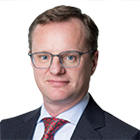
Building the transformation
Investment themes
-
01
Financing the future
Mega forces including AI are transforming economies. We see capital markets – especially private markets – playing a vital role in building this transformation.
-
02
Rethinking investing
This transformation raises questions about how to build portfolios for an ever-changing outlook. We think investors should focus on themes and put more weight on tactical views.
-
03
Staying pro-risk
We remain pro-risk and further upgrade U.S. stocks thanks to U.S. corporate strength. But we stay nimble. Key signposts for changing our views include any surge in long-term bond yields or an escalation in trade protectionism.
Read details of our 2025 outlook:
Transformation underway
Historical trends are being permanently broken in real time as mega forces, like the rise of artificial intelligence (AI), transform economies. The ongoing outsized response of long-term assets to short-term news shows how unusual this environment is. We stay risk-on as we look for transformation beneficiaries – and go further overweight U.S. stocks as the AI theme broadens out. We have more conviction inflation and interest rates will stay above pre-pandemic levels.
2024 has reinforced our view that we are not in a business cycle: AI has been a major market driver, inflation fell without a growth slowdown and typical recession signals failed. Volatility surged and narratives flipflopped as markets viewed developments through a business cycle lens.
As we head into 2025, some countries have new leaders with a mandate for political and economic change. That could see policymakers pursuing measures that add to volatility rather than stability. Financial markets may work to rein in any policy extremes, such as with fiscal policy. Yet we think there will be fewer checks when stocks are running up, creating the potential for risk appetite to turn frothy.
Learning about the trend
For decades, economies followed stable, long-term trends. Investors could focus almost entirely on navigating any temporary deviations around those trends. Growth would eventually converge back toward its trend. That has been a foundational tenet of portfolio construction.
We think the environment is very different now. Economies are undergoing transformations that could keep shifting the long-term trend, making a wide range of very different outcomes possible. See the chart. What’s driving economic growth may look very different.
An ever-changing trend
Hypothetical evolution of U.S. GDP

For illustrative purposes only. Source: BlackRock Investment Institute, December 2024. Note: The charts show an illustration of how economic output could evolve – the chart on the left and top right assumes there is one single central trend for growth and the chart on the bottom right assumes that there is not one single central trend for growth, but many different trends possible.
Checks and (im)balances
2024 was a major election year and a punishing one for incumbent governments. Voters expressed frustration, most notably about the higher cost of living after the pandemic, but also issues like immigration. Several countries have now seen either a change in government or the erosion of ruling party support. The desire for political and economic change could remain driving forces in 2025.
In the U.S., Republican control of both Congress and the presidency means President-elect Donald Trump could implement much of his agenda. If implemented extensively, some of his policies could reinforce geopolitical fragmentation and add to inflation. See the chart. Less government emphasis on macro stabilizing policies – like fiscal frameworks and inflation targets – would put greater onus on financial markets to enforce discipline.
Broadening protectionism
Trade restrictions, 2014-2023

Source: BlackRock Investment Institute, IMF, with data from globaltradealert.org, December 2024. Note: The chart shows the number of unilateral non-liberalizing trade interventions (as classified by globaltradealert.org) taken by countries around the world.
What 2024 says about 2025
Markets have been more sensitive to data surprises than in the past, with even long-term assets having outsized reactions. See the chart. That reinforces volatility. Yet 2024 underscored why trying to overlay a typical business cycle on incoming U.S. data can be misleading when structural forces are at play. Inflation eased, but growth remained strong, driven by structural forces like the post-pandemic normalization of the labor and goods markets and a rise in immigration.
Looking ahead to 2025, we see persistent inflation pressures fueled by rising geopolitical fragmentation, plus big spending on the AI buildout and the low-carbon transition. Slowing immigration may exacerbate the challenges of an aging workforce, keeping wage growth elevated. The Federal Reserve is unlikely to pursue aggressive rate cuts, with rates unlikely to fall much below 4%. Given persistent budget deficits, sticky inflation, and heightened volatility, we expect long-term Treasury yields to climb as investors demand higher compensation for risk.
Sensitive to surprises
Sensitivity of U.S. 10-year yield to economic surprises, 2003-2024

Past performance is no guarantee of future results. Source: BlackRock Investment Institute, with data from LSEG Datastream, December 2024. Notes: The line shows how sensitive the U.S. 10-year Treasury yield is to economic surprises, using regression analysis to estimate the relationship between U.S. 10-year Treasury yields and the Citi Economics Surprise Index over a rolling six-month window. This is only an estimate of the relationship between the 10-year Treasury yield and economic surprises.
Financing the future
The nature of investing is changing significantly, in our view. We think investors can find opportunities by tapping into the waves of transformation we see ahead in the real economy, with AI and the low-carbon transition requiring investment potentially on par with the Industrial Revolution. That’s why our first theme is financing the future. We see capital markets playing a vital role as these mega forces drive a broad infrastructure buildout.
On the rise
Private market assets under management, 2015-2029

Forward looking estimates may not come to pass. Source: BlackRock Investment Institute, Preqin, December 2024. Notes: The chart shows the total assets under management in private market funds with forecasts from 2024 onwards in Preqin’s “Future of Alternatives 2029” report.
Rethinking investing
We think investors should focus more on themes and less on broad asset classes as mega forces reshape whole economies. In other words, the unit of analysis for thinking about returns is changing – and that calls for rethinking investing, our second theme. One key conclusion: with no stable long-term trend and an ever-evolving outlook, investors may want to reconsider what a neutral benchmark is and put greater emphasis on tactical views since investors cannot rely on eventual convergence back to historical trends. Being more dynamic with portfolios and getting granular with views are both essential, in our view.
Ever-bigger share
“Magnificent 7” market cap as a share of the S&P 500, 1995-2024

Past performance is not a reliable indicator of future results. It is not possible to invest in an index. Indexes are unmanaged and performance does not account for fees. Source: BlackRock Investment Institute, with data from LSEG Datastream, December 2024. Notes: The chart shows the combined market capitalization (cap) of the ‘magnificent 7’ stocks (Amazon, Apple, Google, Meta, Microsoft, Nvidia and Tesla) as a share of the S&P 500’s total market cap. The chart sums up the market cap of each stock as they went public, capturing Amazon from 1997 onwards, Nvidia from 1999, Google from 2004, Tesla from 2010 and Meta from 2012.
Staying pro-risk
We are staying pro-risk, our third theme. We see the U.S. still standing out versus other developed markets thanks to stronger growth and its ability to better capitalize on mega forces. We up our overweight to U.S. equities and see the AI theme broadening out. We don’t think pricey U.S. equity valuations alone will trigger a near-term reassessment. But we are ready to adjust if markets become overexuberant. We are underweight long-term U.S. Treasuries on both a tactical and strategic horizon – and we see risks to our upbeat view from any spike in long-term bond yields. We see private markets as an important way to allocate to mega forces and have turned more positive on infrastructure equity on a strategic horizon.
Hardening divergence
U.S. equity performance vs. the rest of the world, 2010-2024

Past performance is not a reliable indicator of future results. It is not possible to invest directly in an index. Indexes are unmanaged and performance does not account for fees. Source: BlackRock Investment Institute, with data from LSEG Datastream. The charts show the indexed performance of U.S. equities compared to the rest of the world. Index proxies used: MSCI USA, MSCI ACWI ex. USA.
Evolving our scenarios
We worked with portfolio managers across BlackRock to evolve our scenarios for 2025 given what we have learned. The new scenarios are U.S. corporate strength and easing supply constraints. See our scenario map below. This recognizes that U.S. corporate strength goes beyond the AI theme.
We think that U.S. corporate strength is the most likely scenario to play out over the next six-to-12 months as earnings growth broadens, even if the economy slows slightly. This highlights the resilience of corporate earnings even if interest rates stay higher.
Staying dynamic
Our scenarios framework helps ground our views on a tactical horizon. We have done so in 2024 as our concentrated AI scenario evolved to our U.S. corporate strength scenario. Yet we could change our stance quickly if a different scenario were to look more likely.
Big calls
Our highest conviction views on tactical (6-12 month) and strategic (long-term) horizons, December 2024
| Reasons | ||
|---|---|---|
| Tactical | ||
| U.S. equities | We see the AI buildout and adoption creating opportunities across sectors. We tap into beneficiaries outside the tech sector. Robust economic growth, broad earnings growth and a quality tilt underpin our conviction and overweight in U.S. stocks versus other regions. We see valuations for big tech backed by strong earnings, and less lofty valuations for other sectors. | |
| Japanese equities | A brighter outlook for Japan’s economy and corporate reforms are driving improved earnings and shareholder returns. Yet the potential drag on earnings from a stronger yen is a risk. | |
| Selective in fixed income | Persistent deficits and sticky inflation in the U.S. make us more positive on fixed income elsewhere, notably Europe. We are underweight long-term U.S. Treasuries and like UK gilts instead. We also prefer European credit – both investment grade and high yield – over U.S. credit on cheaper valuations. | |
| Strategic | ||
| Infrastructure equity and private credit | We see opportunities in infrastructure equity due to attractive relative valuations and mega forces. We think private credit will earn lending share as banks retreat – and at attractive returns. | |
| Fixed income granularity | We prefer short- and medium-term investment grade credit, which offers similar yields with less interest rate risk than long-dated credit. We also like short-term government bonds in the U.S. and euro area and UK gilts overall. | |
| Equity granularity | We favor emerging over developed markets yet get selective in both. EMs at the cross current of mega forces – like India and Saudi Arabia – offer opportunities. In DM, we like Japan as the return of inflation and corporate reforms brighten the outlook. | |
Note: Views are from a U.S. dollar perspective, December 2024. This material represents an assessment of the market environment at a specific time and is not intended to be a forecast of future events or a guarantee of future results. This information should not be relied upon by the reader as research or investment advice regarding any particular funds, strategy or security.
Tactical granular views
Six to 12-month tactical views on selected assets vs. broad global asset classes by level of conviction, December 2024

Our approach is to first determine asset allocations based on our macro outlook – and what’s in the price. The table below reflects this. It leaves aside the opportunity for alpha, or the potential to generate above-benchmark returns. The new regime is not conducive to static exposures to broad asset classes, in our view, but it is creating more space for alpha. For example, the alpha opportunity in highly efficient DM equities markets historically has been low. That’s no longer the case, we think, thanks to greater volatility, macro uncertainty and dispersion of returns. The new regime puts a premium on insights and skill, in our view.
| Asset | Tactical view | Commentary | ||||
|---|---|---|---|---|---|---|
| Equities | ||||||
| United States |  |
We are overweight as the AI theme and earnings growth broaden. Valuations for AI beneficiaries are supported by tech companies delivering on earnings. Resilient growth and Fed rate cuts support sentiment. Risks include any long-term yield surges or escalating trade protectionism. | ||||
| Europe |  |
We are underweight. Valuations are fair. A growth pickup and European Central Bank rate cuts support a modest earnings recovery. Yet political uncertainty could keep investors cautious. | ||||
| U.K. |  |
We are neutral. Political stability could improve investor sentiment. Yet an increase in the corporate tax burden could hurt profit margins near term. | ||||
| Japan |  |
We are overweight. A brighter outlook for Japan’s economy and corporate reforms are driving improved earnings and shareholder returns. Yet a stronger yen dragging on earnings is a risk. | ||||
| Emerging markets |  |
We are neutral. The growth and earnings outlook is mixed. We see valuations for India and Taiwan looking high. | ||||
| China |  |
We are modestly overweight. China’s fiscal stimulus is not yet enough to address the drags on economic growth, but we think stocks are at attractive valuations to DM shares. We stand ready to pivot. We are cautious long term given China’s structural challenges. | ||||
| Fixed income | ||||||
| Short U.S. Treasuries |  |
We are neutral. Markets are pricing in fewer Federal Reserve rate cuts and their policy rate expectations are now roughly in line with our views. | ||||
| Long U.S. Treasuries |  |
We are underweight. Persistent budget deficits and geopolitical fragmentation could drive term premium up over the near term. We prefer intermediate maturities less vulnerable to investors demanding more term premium. | ||||
| Global inflation-linked bonds |  |
We are neutral. We see higher medium-term inflation, but cooling inflation and growth may matter more near term. | ||||
| Euro area government bonds |  |
We are neutral. Market pricing reflects policy rates in line with our expectations and 10-year yields are off their highs. Political uncertainty remains a risk to fiscal sustainability. | ||||
| UK Gilts |  |
We are overweight. Gilt yields offer attractive income, and we think the Bank of England will cut rates more than the market is pricing given a soft economy. | ||||
| Japan government bonds |  |
We are underweight. Stock returns look more attractive to us. We see some of the least attractive returns in JGBs. | ||||
| China government bonds |  |
We are neutral. Bonds are supported by looser policy. Yet we find yields more attractive in short-term DM paper. | ||||
| U.S. agency MBS |  |
We are neutral. We see agency MBS as a high-quality exposure in a diversified bond allocation and prefer it to IG. | ||||
| Short-term IG credit |  |
We are overweight. Short-term bonds better compensate for interest rate risk. | ||||
| Long-term IG credit |  |
We are underweight. Spreads are tight, so we prefer taking risk in equities from a whole portfolio perspective. We prefer Europe over the U.S. | ||||
| Global high yield |  |
We are neutral. Spreads are tight, but the total income makes it more attractive than IG. We prefer Europe. | ||||
| Asia credit |  |
We are neutral. We don’t find valuations compelling enough to turn more positive. | ||||
| Emerging market - hard currency |  |
We are neutral. The asset class has performed well due to its quality, attractive yields and EM central bank rate cuts. We think those rate cuts may soon be paused. | ||||
| Emerging market - local currency |  |
We are neutral. Yields have fallen closer to U.S. Treasury yields, and EM central banks look to be turning more cautious after cutting policy rates sharply. | ||||
Past performance is not a reliable indicator of current or future results. It is not possible to invest directly in an index. Note: Views are from a U.S. dollar perspective. This material represents an assessment of the market environment at a specific time and is not intended to be a forecast or guarantee of future results. This information should not be relied upon as investment advice regarding any particular fund, strategy or security.
Euro-denominated tactical granular views
Six to 12-month tactical views on selected assets vs. broad global asset classes by level of conviction, December 2024

| Asset | Tactical view | Commentary | ||
|---|---|---|---|---|
| Equities | ||||
| Europe ex UK |  |
We are underweight relative to the U.S. and Japan, which remain our preferred markets. Valuations are fair. A growth pickup and European Central Bank rate cuts support a modest earnings recovery. Yet geopolitical tensions, domestic political uncertainty, potential tariffs, and fading optimism about China’s stimulus could weigh on investor sentiment. | ||
| Germany |  |
We are underweight. Valuations and earnings momentum offer modest support compared to peers, especially as ECB rate cuts ease financing conditions. Prolonged uncertainty over the next government, potential tariffs, and fading optimism about China’s stimulus could dampen sentiment. | ||
| France |  |
We are underweight. The outcome of France’s parliamentary election and ongoing political uncertainty could weigh on business conditions for French companies. Yet, only a small share of the revenues and operations of major French firms is tied to domestic activity. | ||
| Italy |  |
We are underweight. Valuations are supportive relative to peers, but past growth and earnings outperformance largely stemmed from significant fiscal stimulus in 2022-2023, which is unlikely to be sustained in the coming years. | ||
| Spain |  |
We are neutral. Valuations and earnings momentum are supportive compared to other euro area stocks. The utilities sector stands to gain from an improving economic backdrop and advancements in AI. | ||
| Netherlands |  |
We are underweight. The Dutch stock market’s tilt to technology and semiconductors—key beneficiaries of rising AI demand—is offset by less favorable valuations and a weaker earnings outlook compared to European peers. | ||
| Switzerland |  |
We are underweight, consistent with our broader European view. Earnings have improved, but valuations remain elevated compared to other European markets. The index’s defensive tilt may offer less support if global risk appetite stays strong. | ||
| UK |  |
We are neutral. Political stability could improve investor sentiment. Yet an increase in the corporate tax burden could hurt profit margins near term. | ||
| Fixed income | ||||
| Euro area government bonds |  |
We are neutral. Market pricing aligns with our policy rate expectations, and 10-year yields have retreated from their highs. Political uncertainty poses risks to fiscal sustainability, but select peripheral markets are bolstered by stronger growth and improving credit ratings. | ||
| German bunds |  |
We are neutral. Market pricing aligns with our policy rate expectations, and 10-year yields have eased from their highs, partly due to growth concerns. We are watching the fiscal flexibility debate ahead of upcoming elections. | ||
| French OATs |  |
We are neutral. France faces challenges from elevated political uncertainty, persistent budget deficits, and a slower pace of structural reforms. The EU has already warned the country for breaching fiscal rules, and its sovereign credit rating was downgraded earlier this year. | ||
| Italian BTPs |  |
We are neutral. The spread over German bunds looks tight given its budget deficits and debt profile, prompting a warning from the EU. Other domestic factors remain supportive, with growth holding up relative to the rest of the euro area and Italian households showing solid demand to hold BTPs at higher yields. | ||
| UK gilts |  |
We are overweight. Gilt yields offer attractive income, and we think the Bank of England will cut rates more than the market is pricing given a soft economy. | ||
| Swiss government bonds |  |
We are neutral. The Swiss National Bank has cut policy rates this year as inflationary pressures eased but is unlikely to reduce rates significantly further. | ||
| European inflation-linked bonds |  |
We are neutral. We see higher medium-term inflation, but cooling inflation and sluggish growth may matter more near term. | ||
| European investment grade credit |  |
We are neutral on European investment grade credit, favoring short- to medium-term paper for quality income. We prefer European investment grade over the US, as spreads are relatively wider. | ||
| European high yield |  |
We are overweight. The income potential is attractive, and we prefer European high yield for its more appealing valuations, higher quality, and shorter duration compared to the US. In our view, spreads adequately compensate for the risk of a potential rise in defaults. | ||
Past performance is not a reliable indicator of current or future results. It is not possible to invest directly in an index. Note: Views are from a euro perspective, December 2024. This material represents an assessment of the market environment at a specific time and is not intended to be a forecast or guarantee of future results. This information should not be relied upon as investment advice regarding any particular fund, strategy or security.






